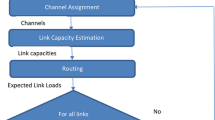Abstract
An important function of wireless networks is to support mobile computing. Mobile Ad hoc NETworks (MANETs) consist of a collection of mobile stations communicating with each other without the use of any pre-existent infrastructure. The self-organization characteristic of MANETs makes them suitable for many real-world applications where network topology changes frequently. As a result, the development of efficient MAC (Medium Access Control) protocols in MANETs is extremely challenging. Self-similar traffic with scale-invariant burstiness can generate bursty network loads and thus seriously degrade the system performance. This paper presents an adaptive MAC scheme which dynamically adjusts the increasing function and resetting mechanism of contention window based on the status of network loads. The performance of this scheme is investigated in comparison with the legacy DCF (Distributed Coordination Function) under self-similar traffic and different mobility models. The performance results reveal that the proposed scheme is able to achieve the higher throughput and energy efficiency as well as lower end-to-end delay and packet drop probability than the legacy DCF.
Similar content being viewed by others
References
Aad I, Castelluccia C (2001) Differentiation mechanisms for IEEE 802.11. In: Proc 20th annual joint conference of the IEEE computer and communications societies, IEEE (INFOCOM’2001), vol 1, pp 209–218
Beran J, Sherman R, Taqqu MS, Willinger W (1995) Long-range dependence in variable-bit-rate video traffic. IEEE Trans Commun 43:1566–1579
BonnMotion, A mobility scenario generation and analysis tool, available on: http://www.cs.uni-bonn.de/IV/BonnMotion/
Broch J, Maltz DA, Johnson DB, Hu Y-C, Jetcheva J (1998) A performance comparison of multi-hop wireless ad hoc network routing protocols. In: Proc of the fourth annual ACM/IEEE international conference on mobile computing and networking (Mobicom’1998), ACM
Camp T, Boleng J, Davies V (2002) A survey of mobility models for ad hoc network research, wireless. Commun Mobile Comput (WCMC): Special issue on Mobile Ad Hoc Networking: Research, Trends and Applications, 2(5), 483–502
Chatzimisions P, Vitasas V, Boucouvalas A, Tsoulfa M (2007) Achieving performance enhancement in IEEE 802.11 WLANs by using DIDD back-off mechanism. Int J Commun Syst 20(1):23–41
Chen B, Lucic Z, Trajkovic L (2005) Simulation and wavelet analysis of packet traffic. http://www.ensc.sfu.ca/people/faculty/ljilja/cnl/pdf/bruce_asi2002.pdf
Gannoune L (2006) A non-linear dynamic tuning of the minimum contention window (CWmin) for enhanced service differentiation in IEEE 802.11 ad hoc networks. In: Proc vehicular technology conference (VTC 2006-Spring), vol 3, pp 1266–1271
Gast M (2002) 802.11 wireless networks: the definitive guide, vol 1, O’Reilly
Hassan M, Jain R (2004) High performance TCP/IP networking concepts, issues and solutions. Prentice Hall, New York
Hong X, Gerla M, Pei G, Chiang C-C (1999) A group mobility model for ad hoc wireless networks. In: Proc ACM international workshop on modeling, analysis, and simulation of wireless and mobile systems (MSWiM)
Lin I-H, Pan J-Y (2005) Throughput analysis of a novel back-off algorithm for IEEE 802.11 WLANs. In: Proc wireless telecommunications symposium, pp 85–90
Mangold S, Choi S, Hiertz G, Klein O, Walke B (2003) Analysis of IEEE 802.11e for QoS support in wireless LANs. IEEE Wirel Commun 10(6):40–50
Mangold S, Choi S, May P, Klein O, Hiertz G, Stibor L (2002) IEEE 802.11e wireless LAN for quality of service. In: Proc European wireless conference, Italy
Ni Q (2005) Performance analysis and enhancements for IEEE 802.11e wireless networks. IEEE Netw 19(4):21–27
Ns-2 simulator, available on: www.isi.edu/nsnam
Paxson V, Floyd S (1995) Wide-area traffic: the failure of Poisson modeling. IEEE/ACM Trans Netw 3(3):226–244
Perkins CE, Bhagwat P (1994) Highly dynamic destination-sequenced distance-vector routing (DSDV) for mobile computers. ACM SIGCOMM Comput Commun Rev 24(4):234–244
Romdhani L, Ni Q, Turletti T (2003) Adaptive EDCF: enhanced service differentiation for IEEE 802.11 wireless ad hoc networks. In: Proc IEEE wireless communications and networking conference (WCNC 2003), New Orleans, Louisiana, USA
Tao Z, Panwar S (2006) Throughput and delay analysis for the IEEE 802.11e enhanced distributed channel access. IEEE Trans Commun 54(4):596–603
Tickoo O, Sikdar B (2003) On the impact of IEEE 802.11 MAC on traffic characteristics. IEEE J Sel Areas Commun 21(2):189–203
Wu H, Cheng S, Peng Y, Long K, Ma J (2002) IEEE 802.11 distributed coordination function (DCF): analysis and enhancement. In: Proc IEEE international conference on communication (ICC’2002), vol 1, pp 605–609
Zhu H, Cao G, Yener A, Mathias A (2004) EDCF-DM: a novel enhanced distributed coordination function for wireless ad hoc networks. In: Proc IEEE international conference on communication (ICC’2004), vol 7, pp 3886–3890
Hwang HY, Kim SJ, Sung DK, Song NO (2008) Performance analysis of IEEE 802.11e EDCA with a virtual collision handler. IEEE Trans Veh Technol 57(2):1293–1297
Ramaiyan V, Kumar A, Altman E (2008) Fixed point analysis of single cell IEEE 802.11e WLANs: uniqueness and multistability. IEEE/ACM Trans Netw 16(5):1080–1093
Xu D, Sakurai T, Vu HL (2009) An access delay model for IEEE 802.11e EDCA. IEEE Trans Mobile Comput 8(2):261–275
IEEE WG 802.11 (1999) Part 11: Wireless LAN medium access control (MAC) and physical layer (PHY) specifications. In: ISO/IEC 8802-11:1999(E), IEEE Standards 802.11
Author information
Authors and Affiliations
Corresponding author
Rights and permissions
About this article
Cite this article
Abu-Tair, M., Min, G., Ni, Q. et al. An adaptive medium access control scheme for mobile ad hoc networks under self-similar traffic. J Supercomput 53, 212–230 (2010). https://doi.org/10.1007/s11227-009-0324-3
Received:
Accepted:
Published:
Issue Date:
DOI: https://doi.org/10.1007/s11227-009-0324-3




